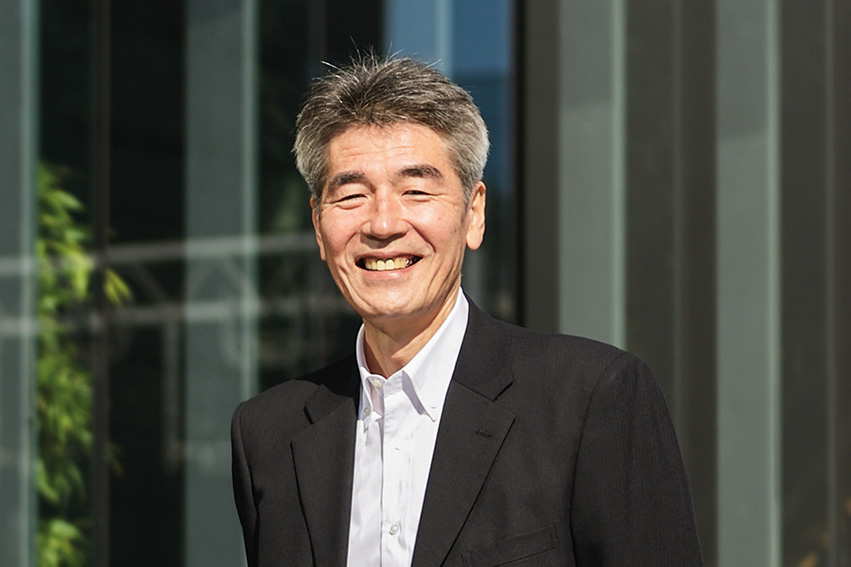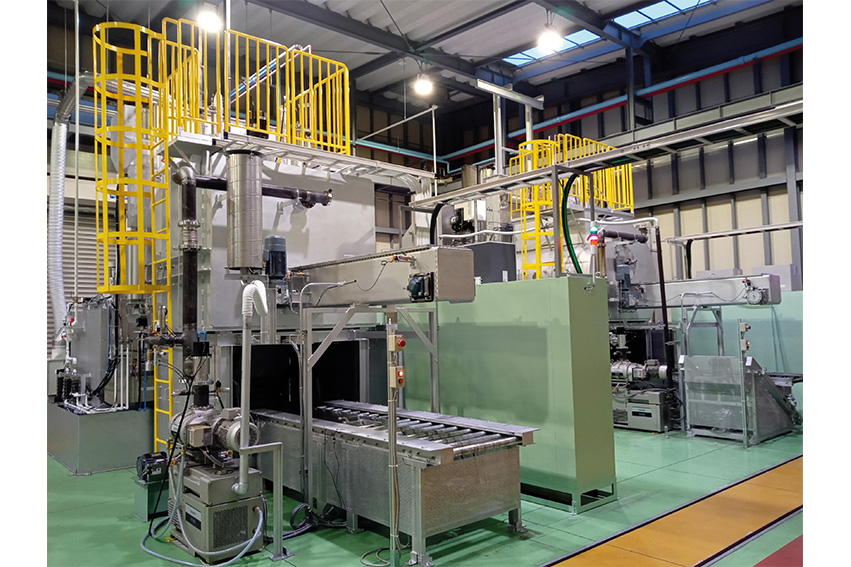Founded in 1958, DOWA Thermotech’s main customers are in the rapidly-changing automotive industry. As carmakers seek lightweight parts for EVs, DOWA Thermotech’s ability to work with the heat treatment of metals such as aluminum is increasing in demand, and its next-generation Z-TKM furnace represents a leap in the sustainability of the automotive industry.

Over the last 25-30 years, Japan has seen the rise of regional manufacturing competitors from countries like Korea, China, and Taiwan, who have replicated the Japanese process, but doing so with a cheaper labor cost, thus pushing Japanese firms out of certain mass production markets. However, we still see that many Japanese are leaders when it comes to niche B2B fields, so with that being said, how have Japanese firms been able to maintain their leadership despite the stiff regional competition?
Our main customers are in the automotive industry so I can only talk about this industry, but compared to Taiwan and China which provide new products at a low cost, the advantage of Japanese products is the long history of monozukuri as well as the reliability that it has acquired over time. Currently, in the automotive industry, there’s been a once-in-a-century transformation to electrification of cars and with that, the situation around the automotive industry is changing, but I strongly believe that Japan still has an advantage with the quality and adaptability of technology.
And on that point about electrification, of course, as you said, it is a once-in-a-lifetime chance to move away from gas vehicles to electrification, but with the switch, many new vehicles require newer specifications, Of course, they need to be lighter to offset the weight of the lithium-ion battery, and as such we are seeing the utilization of newer materials like aluminum, magnesium and carbon-fiber-reinforced polymers (CFRP), so what impact is this material shift having on your business?
Our technology and solution are mainly used in the power train or the structure of the automotive itself, so it still uses ferrous material, but of course, the trend is to go lightweight, and to do so our heat treatment technology contributes through the hardening of the surface of each component.
When it comes to metals use, we know, especially for heat treatment, some materials, for example, aluminum, need to have very controlled temperatures to reduce the overheating of the melt to ensure the best quality outcome. How are you able to ensure strict temperature control in the furnaces and services that you provide to customers?
We have extensive accumulated experience working with aluminum over 20 or 30 years, so we have the know-how to handle that material. The issue with aluminum is that it has a low melting temperature and the tolerance level is quite narrow, so the temperature control must be very stringent, but this temperature control is nothing unique to our company. It’s basically the same temperature control method used by other companies.
This also coincides with what you said about Japan having a long history of monozukuri, but given Japan’s demographic situation, being the oldest society in the world with a rapidly shrinking population, with estimates that in the next 15 years, one in three people will be over the age of 65, maintaining your know-how and passing on this history of monozukuri is going to become more and more challenging. And, of course, there is a labor crisis, a small pool of graduates coming through for companies to replace their older workers with. But there’s also a shrinking domestic market at the same time. So what have been some of the challenges this demographic shift has presented for DOWA Thermotech and how have you been reacting to it?
The shortage of labor is an immediate issue experienced by all Japanese companies. As for our company, what attracts human resources is compensation, so we are trying to make adjustments to the compensation level, but we have to be mindful that the rise in salary impacts our finances. At the same time we are hiring more of the senior generation as well as foreign workers and women, we are trying to introduce automation and robotics, especially in the heat treatment process which relies heavily on manual labor when the product is placed onto a jig, when it is placed into the furnace, and when it’s taken out from the furnace. So, introducing robotics for pre- and post-furnace burning is what we are trying to do; however, it’s more of a high-mix, low-volume production scheme that we do so it’s very hard to standardize the procedure, but we are trying to figure out the best way to operate robotics within our factory.
We also have developed our own software, D-IPS, which monitors and assures the quality of the product as well as watching over and monitoring the furnace itself. The strength we have is that we have this software aspect as well as the hardware facility provision so having both ends strengthens our product solution.
And speaking of digital utilization, in 2022 DOWA Thermotech released the Z-TKM, a next-generation carburizing and quenching furnace that can be used with a hydrogen burner, heat treatment applications for automobiles, construction machinery, industrial robots, and much more. However, it allows the utilization of digital technologies for the reduction of maintenance costs as well. Can you go into more detail about how the Z-TKM is superior to more conventional furnaces and heat treatment devices on the market?
The reason behind the development of the Z-TKM series is a concern for the environment, with the aim of achieving carbon neutrality. In Japan, annually, there are about 1.18 billion tons of carbon dioxide emissions and 25% come from the industrial field. Among that, 25%, which is equivalent to about 70 million tons of CO2, is emitted from industrial furnaces. Our companies have installed over 3,500 furnaces and in-house we have 240 heat treatment furnaces, so we felt a huge responsibility to convert the energy source and also the operating method to achieve carbon neutrality. The conventional furnace requires a process gas, but we have developed the vacuum-carburizing furnace.

Z-TKM furnace
On the carbon neutrality point, we know you developed a proprietary, low-temperature gas nitrocarburizing method, which is a nitriding process that can cause less distortion and less pollution. Therefore, I’m very curious to know more about the development of this unique nitrocarburizing method and some of the market needs you identified when developing the method.
So the biggest advantage of using a nitriding method for heat treatment compared to the conventional carburizing method is that it does not emit CO2 and also it does not require the use of the methane (CH4) processed gas, which is harmful to the environment, so that has been the uniqueness of using nitride technology. This technology has been there for quite some time and has been used in the automotive industry, but there’s been a hindering issue since the manufactured component could be brittle. To overcome this issue, we have collaborated with the automotive parts manufacturer and the material providers to come up with our unique “HARDERNITE ®” technology but this technology is only applicable to this specific material created by this partnering of material producers so what we did was to develop a newer technology that could be applied to any type of general material requiring heat treatment. This technology is called DNTN and we target the year 2026 to start launching the product for EV unit heat treatment.
I think this collaboration is a very good example of how you are able to work with other companies and create something new and innovative to meet the demands of the market. This is a common theme that I see, companies relying on the expertise, knowledge, and know-how of a partner firm in order to create these new technologies. But when it comes to creating new products, or even collaborating, are you open to working with overseas firms as well?
We have a partnership in China, India, and Italy. And regarding India, we have over 40 years of experience working with the local partner. Usually, when we go overseas, there’s a Japanese-affiliated Nikkei company that has ensured a purchase or relationship, but with India, we have a local partnership. As for China, we did have a local partner because at that time it was very difficult for foreign companies to establish themselves, but now this company has actually become our own subsidiary, our own branch.
As for our overseas strategy we want to strengthen our presence in the European and American regions, finding local partners, since with the shift to EV, it’s hard to predict how much of a shift it would be with Big 3 and Tesla, but it seems like a new supply chain has now been created within the US market, so we see there may be a chance for us. We have a factory in Ohio; however, we’re not putting our industrial furnace strength yet in the US, so finding a local partner who could take care of the maintenance or the sales aspect would be the ideal partner we are looking for.
You mentioned how usually when you go abroad you already have a Nikkei partner or a customer in the market that you’re trying to penetrate. As for the US or North American market, is it the same strategy that you’re using through Japanese companies, or as the country is undergoing a new supply chain, are you also looking to find new customers? If yes, it would be great if you could highlight to them what are the key advantages of your company, and what solutions you can provide to them.
Yes, we know it is very difficult to penetrate the US market with the existing supply chain but with the new Z series and also a cell-type vacuum industrial furnace, we want to focus more on the industrial furnace business rather than heat treatment.
In fact, our subsidiary in India is playing a vital role in our international strategy. This Indian company already has relationships with many Western companies whereas our headquarters have a deeper relationship with Nikkei companies. So, combining the technology know-how and the sales and customer network we want to work together to cover the world market.
As your company is celebrating its 66-year anniversary, let’s project ourselves in the future for four years for your 70-year anniversary, in which we will be coming back and have this interview with you. What would you like to tell us? What are your dreams and goals that you would like to achieve over the next four years? And to finish this interview, could you please define how you would like your company to be seen through the eyes of the international market?
When you come back in four years for the 70th anniversary, I have high hopes for the company to be number one in both the industries of heat treatment and industrial furnaces. The strength that we have is that we are a double-pillar company of heat treatment and industrial furnaces and we have this synergistic effect by having two pillars, but we want to excel as number one in both areas.
Speaking of heat treatment, the automotive industry is a very niche field and for business continuity purposes, it’s not like a monopoly of one specific company but rather the market is shared amongst multiple companies. As I mentioned, there are three major companies sharing the pie, but within these three we want to be the top runner and from overseas we won’t be recognized as the top runner in the industry.
0 COMMENTS